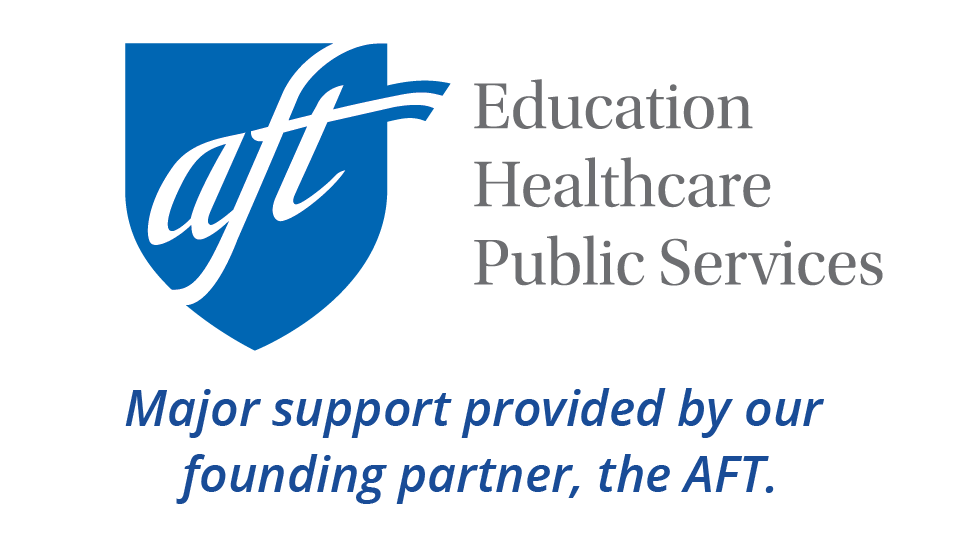We want to connect families with the resources they need to maintain their home and stability in the community.
— Kristina Robertson, English Learner Program Administrator, Roseville Public Schools (MN)
Overview
Download PDF versions:
There is a constellation of factors that can impact an immigrant family's economic situation, along with housing or caregiving arrangements that may also be in flux.
Staying attuned to clues can help educators identify challenges students are facing. Community organizations and community schools can also play a valuable role in helping to meet the basic needs of immigrant students and families. Learn more from the strategies and resources below.
Note on seeking legal guidance
This guide includes numerous resources providing useful information for educators. While some of those resources include advocacy information, Colorín Colorado and our parent organization, public broadcasting station WETA-TV-FM, do not take political positions or participate in political advocacy.
In addition, the information in this guide should not be interpreted as legal advice. Any individual or organization seeking legal advice related to immigration issues should consult with the appropriate attorneys, local government officials, or non-profit organizations specializing in immigration law that can offer guidance. We also remind educators not to provide legal advice.
Keep in mind that immigrant families' economic situations may change
Why this matters
The ways in which immigration issues relate to families' economic situations are complex, especially when those situations or immigration policies change. Sometimes the changes are immediately visible; other times they are hidden, in part due to families' reluctance to draw attention to their situation.
Understanding how these issues are related is a good first step to addressing challenges that may impact students' abilities to be successful in the classroom. For example, students may not have some of their basic needs met. For example, breadwinners' employment situations may change because:
- they lose employment following an immigration raid, even if they were not detained (Gándara and Ee, 2018a)
- they choose to leave their jobs to avoid workplace immigration raids
- they experience extended, unexpected separations
- they are detained or deported
- they are limited in transportation options, especially if undocumented
- families are moving often, making it difficult to maintain employment.
In addition:
- Immigrant families may decide not to register for benefits regarding food, housing, medical care, and disaster relief, foregoing benefits they previously used.
- Children may be cared for by another adult, relative or older sibling.
- Immigration proceedings can be costly.
- Landlords and employers may exploit undocumented families.
- Families may be scaling back on their expenses.
- Families may be uncertain about how future policy changes will impact their situation.
- Families may be concerned about proposed rule changes related to legal immigrants using public benefits and deciding to turn those benefits down.
Related news headlines
- Families Affected by Mississippi ICE Raids Scramble to Find Support (NPR)
- Their parents were taken in Mississippi immigration raids. For these kids, the trauma is just beginning (CNN)
- How to pay the rent? ICE raids leave Mississippi community jobless and scared (Clarion Ledger)
Examples from the field
ELL administrator Kristina Robertson writes,
We see the financial effects families have experienced – for example, if a father has been the main wage earner and he is detained, the family is missing significant income. This impacts their ability to pay the rent or mortgage, buy food, and in some cases impacts transportation if the remaining parent doesn’t have a driver’s license.
In addition, if the detained person is released on bail, our immigrant lawyer consultant said they would likely have to pay thousands of dollars for the bond. If a person is detained for many weeks, they are likely to lose their job and the family may lose their housing and have to start in a new community.
Service providers who work with immigrant families are also beginning to see the impact of economic uncertainty on the families they serve. Lariza Dugan-Cuadra, Executive Director, of the Central America Resource Center (CARECEN), notes, "Our attorneys are doing quasi-social work. Unable to work and pay rent, many of those awaiting their immigration proceedings have become homeless or unstable in the process."
News outlets NBC 4-New York and KCUR Public Radio have reported that many families are foregoing benefits such as food stamps through the Supplemental Nutrition Assistance Program (SNAP), and preliminary research presented in late 2018 shows that the number of immigrant families enrolled in SNAP dropped 10% in 2018. While there may be a variety of reasons for the change, researchers cite families' concern about immigration status as likely to be a key factor.
Kristina also confirms that she is seeing this on the ground:
We've also had a huge drop in our government food benefits program locally even for legally born children…currently our food pantries are strained to the max as families try to make use of local support…This also means they are less likely to take advantage of other school programs that their children may qualify for such as school lunch. (Personal communication, November 21, 2018)
There are also reports that some immigrant families are foregoing medical immunizations and medical appointments, while researchers with CLASP report that families are also skipping prenatal care, therapeutic services, hospital visits, and registration for programs like WIC for fear of immigration enforcement (Cervantes, Ullrich, & Matthews, 2018, p. 15).
And as a general rule, undocumented families have less access to health care and prevention services. (You can read more about that topic in this related report from the Migration Policy Institute.) Some localities are working to help address these gaps; for example, The Washington Post reports that in April, "the school board in Las Cruces, N.M., passed a resolution promising to provide free and reduced cost meals, rides, health care, education and extracurricular services to undocumented immigrant students."
One teacher who filled out our 2017 survey on how schools are supporting immigrant students writes,
Eye-opening for me was when I took a survey of the number of students who work after school at full time jobs; often second shift late into the night. Helping to pay rent becomes a priority. Often, school falls by the wayside…It was surprising for me to find that 10 out of 10 ELLs in one particular class all worked in their home countries in agriculture as child laborers. Younger children went to school in the mornings and worked in the fields in the afternoons. Older children worked in the mornings and went to school in the afternoons.
Tips for getting started
- Look for clues about what is happening in students' lives rather than asking questions.
- Take time to listen to students when they wish to talk to you.
- Keep an eye out for economic distress among your students.
- While it's important not to make assumptions or draw unwanted attention to families, consider having some discreet conversations if you notice an issue.
- Talk with counselors, social workers, or administrators about how to best support families struggling to make ends meet.
- Think about broader solutions if there seems to be wide-scale issues impacting multiple families, including partnering with organizations that can help address basic needs.
- Look for ways to increase access to these services broadly. One respondent to our survey wrote, "All of our immigrant families are given access to the meals program, community help, and free- and-reduced lunch when they enroll at our schools."
In addition, keep in mind the following:
- Immigration status may impact ability to secure basic services or benefits, such as:
◦ Food
◦ Housing and utilities (such as heating assistance in the winter)
◦ Social-emotional/mental health services
◦ Medical and dental care
◦ Transportation
- Students may be afraid to share what is happening for fear of being separated from family members or siblings.
- Immigrant and newcomer families may also have specific needs related to natural disasters. Learn more in Why Immigrant Families May Have Unique Needs Before, During, and After Natural Disasters.
Recommended resources
- Strategy: Engage ELL families through community partnerships (ELL Family Engagement Guide)
- Working with Community Organizations on Behalf of ELLs
- Community Schools: A Strategy for Success
- Social and Emotional Needs of Middle/High School ELLs (Michelle Lawrence Biggar, NY)
- Health-Related Resources for Immigrant and Refugee Families (Grantmakers Concerned with Immigrants and Refugees)
Recommended videos 
For more ideas on helping to meet the basic needs of students, see our Community Schools project featuring Wolfe Street Academy in Baltimore, MD, as well as the videos below:
Video playlist: Educators reflect on Maslow’s Hierarchy of Need
Ensure that students experiencing homeless have appropriate services
Why this matters
When immigrant students experience homelessness, they have additional educational rights under the federal McKinney-Vento Act (KIND and NAEHCY, 2010). Homeless students may not have documents required for school enrollment (U.S. Department of Education, 2015), yet they are still guaranteed a right to a free public education. See more on this issue from the following:
- Immigration and Schools: Supporting Success for Undocumented and Unaccompanied Homeless Youth (KIND & NAEHCY, 2010)
- Educational Rights of Immigrant Students (AFT tip sheet)
The authors of the above report from KIND and NAEHCY explain that reasons for homelessness in this population include:
- coming to the country unaccompanied
- separation from family as a result of parental deportation
- separation from family as a result of limited space/rules at homeless shelters
- separation from family as a result of abuse, neglect, abandonment, or family discord
- being forced to leave home as a punishment for pregnancy or revealing that they are gay, lesbian, bisexual, or transgender.
The researchers also note that undocumented homeless youth face unique challenges because they:
- cannot work legally
- are not eligible for most health insurance, health care services, and financial aid.
Students may also be afraid to reveal that they are homeless, as in the story Anne Marie Foerster Luu shares in the recommended video below, "A Student Who Was Homeless." It is also important to note that some immigrant students may be:
- sharing housing with other families
- moving often due to immigration concerns
- having trouble establishing housing when they arrive in a new community.
Finally, it is important to note that large immigration raids such as those in Mississippi in August 2019 can leave multiple students at risk for homelessness. The Intercultural Research Development Association explains that supports for homeless students based on the "McKinney-Vento" Act can play an important role in helping students who might have been left homeless after the raid.
Tips for getting started
We recommend the report by KIND and NAEHCY for additional legal guidelines related to this population, as well as the tips and strategies included in the guide for educators and immigration attorneys.
Recommended resources
For additional information on this issue, see the following:
- This related report on homeless newcomer youth in Toronto (Center for Addiction and Mental Health, Canada)
- Far from Family, Alone, Homeless and Still Just 18 (The New York Times)
Recommended videos 
Video: A student who was homeless
Video: Challenges in finding affordable housing
Video: Family mobility
Video: How community schools increase student engagement and decrease family mobility
Keep in mind families' needs related to natural disasters
Your families may also have unique needs, circumstances, and challenges leading up to, during, or in the wake of a natural disaster. Learn more about how schools can help in this related article.
References
See our complete reference list for works cited in this article.







Add new comment